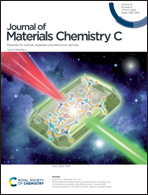Solution-processable phenothiazine and phenoxazine substituted fluorene cored nanotextured hole transporting materials for achieving high-efficiency OLEDs†
Abstract
Solution-processable hole-transporting materials (HTMs) are key functional materials for high-throughput and inexpensive fabrication of high-efficiency organic light-emitting diodes (OLEDs). Herein, we have successfully synthesized a novel series of phenothiazine and phenoxazine substituted fluorene core-based HTMs, i.e. 10-hexyl-3-[2,7-di(naphthalen-1-yl)-fluoren-9-ylmethylene]phenoxazine DNFPhe, 10-hexyl-3-[2,7-di(4-(diphenylamino)-phenyl)fluoren-9-ylmethylene]phenoxazine DDPFPhe, 10-hexyl-3-[2,7-di(4-fluorophenyl)-fluoren-9-ylmethylene]phenoxazine DFPFPhe, 10-hexyl-3-(2,7-diphenylfluoren-9-ylmethylene)phenoxazine DPFPhe, 10-hexyl-3-[2,7-di(4-(diphenylamino)phenyl)fluoren-9-ylmethylene]phenothiazine DDPPFPh, and 10-hexyl-3-[2,7-di(naphthalen-1-yl)fluoren-9-ylmethylene]phenothiazine DNFPh, and incorporated them in solution-processed phosphorescent and thermally activated delayed fluorescence (TADF) OLEDs. The synthesized HTMs exhibit superior solubility in organic solvents and display nanotextured surface morphologies. These HTMs possess high hole-mobilities as compared to a conventional HTM, N,N′-bis(naphthalen-1-yl)-N,N′-bis(phenyl)-benzidine (NPB). By incorporating a phosphorescent bis(4-phenylthieno[3,2-c]pyridinato-N,C2′) (acetylacetonate) iridium(III) (PO-01) yellow emitter, we demonstrate an improvement in maximum power efficacy (PEmax) from 41.6 to 45.4 lm W−1, current efficacy from 39.8 to 50.6 cd A−1, external-quantum efficiency (EQEmax) from 12.9 to 19.6%, maximum brightness (Lmax) from 15 200 to 19 400 cd m−2, and a lifetime (LT50) from 151 to 465 h at 1000 cd m−2 initial luminance of a phosphorescent OLED by substituting the conventional HTM, NPB, with DDPPFPh. Additionally, the 2,4,5,6-tetra(9H-carbazol-9-yl)isophthalonitrile (4CzIPN) green TADF emitter-based OLED displays the enhancement in PEmax from 42.5 to 69.1 lm W−1, CEmax from 54.1 to 78.0 cd A−1, EQEmax from 20.1 to 27.2%, Lmax from 12 900 to 44 200 cd m−2 and LT50 from 195 to 590 h at an initial brightness of 1000 cd m−2 by replacing NPB with DDPPFPh. Based on these findings, the reported solution-processable HTMs appear to be promising candidates for high-efficiency OLEDs.

- This article is part of the themed collection: Editor’s Choice: Malika Jeffries-EL


 Please wait while we load your content...
Please wait while we load your content...